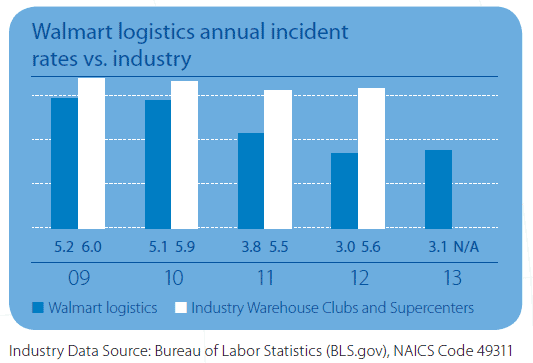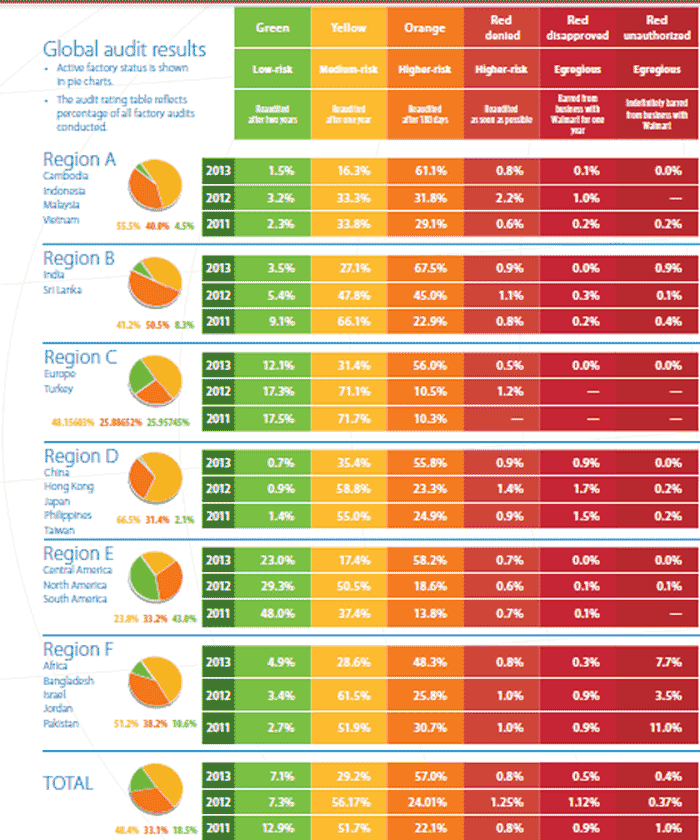Walmart has released its Global Responsibility Report for 2014, a massive 186-page document that tracks its goals and success across an amazingly wide variety of sustainability and social responsibility initiatives.
We'll summarize some of the highlights here.
New CEO Doug McMillon noted in his introduction that early in Walmart's sustainability journey, it realized it probably needed to start listening a little bit more to its critics. That, of course, is hard for any company to do.
"In fact, some of our critics then are some of our best advisors now," he said.
In a related interview at the front of the report, McMillon also addressed the apparel factory disaster in Bangladesh, and program Walmart led to drive safety inspections in the country (there is a rival European program that goes even a little further), saying that Walmart "has made the results of more than 200 Bangladesh factory safety assessments publicly available as of March 2014."
McMillon also says Walmart is working to remove certain chemicals from the products it sells when it believes there is a more environmentally friendly alternative. He implies Walmart is forcing suppliers to detail what chemicals they use, so Walmart can work with them on potential alternatives. He adds that Walmart will report on this initiative in 2016.
To tackle both environmental and social issues, Walmart has created a series of what it calls Sustainable Value Networks (SVNs), which are global networks of Walmart merchants, operators and finance leaders. There are SVNs for food and agriculture, soft goods, energy, transportation, etc. The SVNs are charged with creating and executing sustainability/social initiatives within their focus areas. The goal is to identify solutions and "embed" them in Walmart's day-to-day operations.
Below, we look at some results across different areas of Walmart's business:
Compliance: Walmart now has 2000 people in its global compliance team, which includes everything from anti-corruption efforts to food safety to responsible sourcing. This group has recently been consolidated into a single organization from 11 regional ones.
In the food safety area, Walmart is now using the SPARK (Sustainable Paperless Auditing and Record Keeping) system, through which associates complete food safety tasks in stores and clubs. The SPARK system utilizes innovative hand-held technology, Bluetooth communication and a state-of-the-art temperature-measuring device connected to a real-time database and various analytics.
In the area of employee safety in Walmart's massive distribution operations, Walmart has developed a training and certification program for the use of lift trucks of various types. Almost 61,000 workers have been certified for safe use of electronic power jacks, for example. That program is powered by a new system that tracks both training and accidents in the warehouse.
In September 2013, the Walmart US West Business Unit launched the" I Own Safety" program, which was created to further reduce accident exposure and costs through recognition and accountability. Under the program, salaried members of management write up an I Own Safety card and publicly deliver it to an associate when they observe him or her exhibiting safe work behaviors. In addition, Walmart now tracks conversations between management and DC staff relative to safety – so far, there have been some 230,000 conversations just in the West region stemming from the I Own Safety program, and 75% have been positive ones relative to desired behavior. The program will be expanded to the other US regions in 2014.
As a result of all this, Walmart has been able to lower its rates of incidents in its US DCs versus others in the industry, as shown below:

All told, lost time due to injury is down some 50% from a variety of safety efforts over the past few years.
In terms of responsible sourcing, Walmart now has 140 responsible sourcing staff members operating across the globe. This staff is of course on top of its huge team of regular buyers.
Walmart also now has something it calls the Responsible Sourcing's Supplier Development Program, in which it proactively works with our suppliers to help improve standards and effectively manage their factories. To participate, a supplier must be nominated by someone within Walmart. A consulting team then works with the supplier to conduct a thorough analysis of every area of the business that impacts performance in responsible sourcing and develops a customized plan that drives meaningful improvement. In 2013, 68 suppliers took part in the program.
Below is a chart that summarizes the audit results for factories making products for Walmart across the globe, by region. As can be seen, there was a big jump in most regions to supplier factories being in the orange or high risk area, at the expense of companies in the green (low risk) or yellow (medium risk) areas.
Walmart Supplier Audit Results in 2013 by Region

The report does not make clear why this is, although it appears it could be related to tougher fire safety standards.
Social: Under the food area within social-related programs, in 2013 Walmart continued its roll out of the "Good for You" icon for its own private label food items, and allowed the icon to be used by branded companies as well.
Walmart opened another 96 stores in areas of the US deemed "food deserts" by the Census Bureau, or areas that have no solid grocery options nearby. That brings the total to 224 such new stores, with more to come.
Walmart is committed to greater sourcing from women and minority-owned businesses. That includes recent development of scorecards to ensure merchants and senior managers have visibility into the women-owned businesses and diverse suppliers they work with and how each area of the business is tracking against its target.
In January 2013, Walmart announced that within 10 years, it will source an additional $50 billion annually in products supporting US manufacturing. "That's an estimated $250 billion spent on products that support more affordable US production and create American jobs," the report says.
Walmart adds "We think U.S. manufacturing is poised for a comeback and believe this revitalization is essential to rebuilding the middle class."
Environment: Walmart's goal is to be powered by 100% renewable energy and have a 100% waste-free operation. Towards the former goals, it plans to Drive the production of procurement of 7 billion kilowatt hours of renewable energy globally by Dec. 31, 2020.
With regard to driving environmental improvement in its suppliers, Walmart has rolled out its famous Sustainability Index to more than 700 product categories across its business. Hundreds of buyers from Walmart US, Sam's Club and several international markets are now using this tool to work with their suppliers on improving product sustainability.
For seven consecutive years, Walmart has reduced its Scope 1 and 2 carbon intensity, and says it is on track to hold absolute emissions flat over this decade, despite continued growth. Greenhouse gas emissions per sales dollar have dropped about 20% since 2006.
Perhaps surprisingly, the vast preponderance of Walmart's renewable energy projects (86%) as measured by energy production come from wind. Just 6% comes from solar energy. That said, Walmart notes it installed its 250th solar energy system in the US, with each system providing 15- 30% of a store's electricity needs.
With regard to its fleet operations, in 2013, Walmart delivered an additional 181 million cases in the US while driving 167,000 fewer miles than in 2012, primarily through better network efficiencies in reducing things like empty miles (implies greater use of customer pick-ups from vendors). Walmart also cited better trailer utilization and truck routing.
That efficiency saved the company nearly $65 million and avoided almost 25,000 metric tons of CO2, which is the same as taking 5,000 cars off the road.
As SCDigest recently reported (see Walmart Unveils New WAVE Concept Truck - a Very Different Design for Sure) Walmart noted its new prototype of what is called the Advanced Vehicle Experience tractor and trailer. The truck has a very aerodynamic design (20% improvement), uses carbon fiber for the trailer to reduce its weight by 4000 pounds, and uses a hybrid engine.
Perhaps oddly, it seems that Walmart is a bit behind others in the move to natural gas powered trucks, saying it continues to test the technologies for both liquid and compressed natural gas, and that it is evaluating performance and reliability of the equipment, maintenance impacts, fuel economy, access to fuel, overall cost and life cycle sustainability.
There's a lot more, but you get the idea. The full report, which covers simply an amazing scope of activities, is available here: Walmart 2014 Global Responsibility Report.
Any reaction to Walmart's 2014 GRR? Let us know your thoughts at the Feedback button below.

|